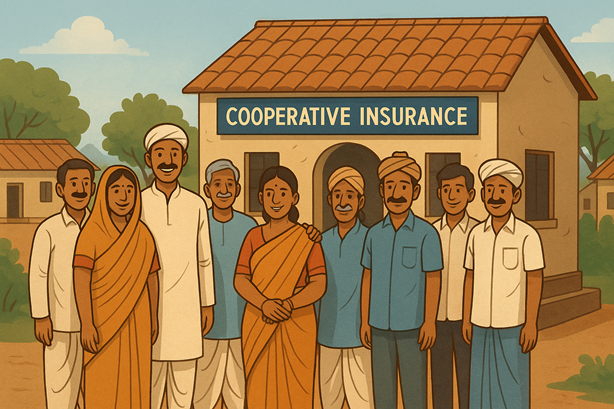
India’s insurance penetration is still under 4%, and the gap between rural Bharat and urban India remains vast. While private insurers grow rapidly, their reach often ends where profitability does. This brings us to a critical question:
Can cooperative insurance fill this gap — and how?
The recent statement by Union Home Minister Amit Shah about exploring the idea of cooperative insurance companies further intensifies this debate. India already has a deep-rooted cooperative network. Could this be the foundation for a new model of community-driven insurance?
Here are 6 key realities explaining why India needs cooperative insurance and what must be understood before implementing it at scale.
1️⃣ Insurance Still Isn’t Inclusive
Despite government schemes like PM-JAY, PMFBY, and Ayushman Bharat, large parts of India remain uninsured or underinsured. Private players focus on urban and salaried customers. A cooperative model can help reach underserved populations — because it’s community-based, not profit-driven.
By bringing affordability, trust, and access together, cooperative insurance can serve the people who need protection the most, especially farmers, labourers, and daily-wage earners.
2️⃣ Trust Is a Major Barrier — Co-ops Can Solve It
Trust in financial products is low among rural users. Many people still avoid buying insurance due to fear of fraud, delayed claims, or confusion. But cooperative structures, like PACS and credit societies, already enjoy social credibility. A cooperative insurance company can leverage that familiarity to improve insurance adoption.
Additionally, in a cooperative model, the policyholders are also stakeholders — which creates a sense of ownership and mutual accountability. Global examples — such as those promoted by the International Cooperative and Mutual Insurance Federation (ICMIF) — prove that member-owned models build long-term trust and participation.
3️⃣ IRDAI Regulation Is Still Evolving
As of today, IRDAI doesn’t offer a cooperative-specific insurance license, but future frameworks are possible. The regulator has been introducing progressive steps like sandbox approvals, microinsurance, and simplified compliance for small insurers.
A cooperative insurance company might start as a:
- Microinsurance provider
- IMF (Insurance Marketing Firm)
- JV with a cooperative bank
Licensing will require capital, governance structure, and compliance — similar to existing insurers.
A possible road forward could be a multi-state cooperative society applying for limited-scope insurance licenses with IRDAI’s approval.
IRDAI.gov.in
4️⃣ Distribution Network Already Exists
India’s cooperative banks and rural societies already have a presence across 6.3 lakh villages. These institutions can distribute insurance, collect premiums, and even assist with claims — all with local accountability.
This gives cooperative insurance a ready-made network, unlike new startups that struggle with trust and reach. Using digital tools like Aadhar-enabled services and mobile claim registration can further streamline this ecosystem.
5️⃣ Cooperative Governance Has Risks
The model also has challenges:
- Weak governance in some co-ops
- Political interference
- Skill gaps in financial planning and risk
- Lack of technology usage
- Dual regulation confusion (RBI + IRDAI)
These need clear compliance, professional leadership, and tech integration to succeed. Training, digitisation, and performance-linked governance systems will be essential for long-term success.
6️⃣ 2025 Might Be the Turning Point
With statements from leaders like Amit Shah advocating for cooperative insurance companies, the shift seems likely. If India can blend cooperative ethics with modern insurance frameworks, we could see a game-changing model emerge in 2025 and beyond.
The cooperative sector has been historically underleveraged. With rising insurance awareness and digital inclusion, the time may finally be right for this people-powered model.
🧭 Conclusion
Cooperative insurance in India is not a fantasy — it’s a real, scalable possibility if executed with structure, transparency, and intent. With the right support from IRDAI, government think-tanks, and the cooperative ecosystem, India could create an insurance model truly owned by the people, for the people.
It’s not just about selling policies — it’s about building trust, access, and dignity into the system of protection.
🔸 Also read: Why Underwriters Are the Backbone of Every Insurance Company
